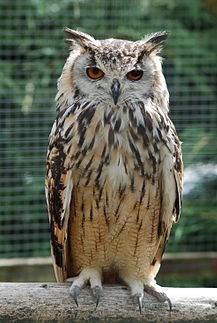Horned Owl en.wikipedia.org
Most of us have seen owls in our surroundings. Owls are hard to be seen in natural settings because they usually remain active during nights only. However, in a dense orchard or forests owls can be seen during day time also.
Habitat of Owls
If there is a dense garden somewhere or near our house or an old deserted building or a monument, we can hear hoots, screeches, hisses and screams of owls even during day time.
Owls mostly prefer a habitat away from human habitation. This is why their screeches are often heard during nights in crop fields and deserted areas.
Owls can produce a wide variety of sounds or vocalizations. Their vocalizations are loud but low pitched. Their cries travel well through the night air and enable them locate mates and declare territories despite darkness.
However, owls see, observe and hear much more than they speak. This is the reason why owls are called as “wise owls”. Here are some lines of a poem on owls –
The wise old owl, Sat in an oak.
The more he saw, the less he spoke.
The less he spoke, the more he heard.
Why can’t we be like that wise old bird?
External makeup of Owls
Owls are nocturnal hunting birds. They have eyes facing forwards. They usually sleep during the day and emerge at night to hunt small prey. The specific eye placement in the head of an owl gives him binocular vision and very precise depth perception. There are circles of radiating feathers that surround each one of the two eyes. These feathery circles give them wide eyed alert look. They cannot move their eyes, and in order to look around, they have to move their entire head up to 270 0.
One may be surprised to know that an owl has three eye-lids – one for blinking, one for sleeping, and one for keeping the eye clean and healthy. They have Zygodactyl feet that means – feet having half of toes pointing forward and others pointing backwards.
Owls have specialized feathers that muffle sound when they fly. Their silent flight helps them catch prey more easily.
Owls have been found in the fossil record up to 58 million years ago. The largest recorded owl fossil orenmegalonyx oteroi stood about three feet tall.
Where are owls found?
Owls are found everywhere in the world. There are about 162 different species of owls alive today. They inhabit a huge variety of ecological niches – from rainforests to tundra. In India, owls are found everywhere ranging from rural, semi-urban to urban settings.
Food of Owls
Owls hunt and eat rodents, insects, frogs, and birds. They eat smaller prey whole and larger prey in chinks. An owl is at the top of the food-web and it has no major predators except man.
Vahanas of Goddess Laxmi
Owls have been regarded as Vahanas of Goddess Laxmi in the Hindu mythology. This consideration gives some importance to this bird. However, Hindu tantriks recommend owl worship during mid night of some particular day. This thought has encouraged unlawful hunting and killing of owls in India.
Carrier of evil spirits
Some people think owls to be carrier of evil spirits. It is due to this type of bad thought that owls are captured and killed mercilessly for evil purposes. Owls are being caught, captured and poached in many different parts of India including Bihar, Bengal, and Jharkhand. These are sold in markets during Deepawali season on high rates.
Friends of Farmers
Owls are friends of farmers. They kill and eat away large number of field rats that harm their crops. It has been reported that a family of hungry owls can consume more than 3000 rats in a nesting season. Thus owls offer great help to farmers and act to balance local food -chain. Farmers should install predatory cans in their fields on some heights to allow owls sit there during nights.
Owls in Traditions and Cultures
Owls have been variously symbolized as dread, knowledge, wisdom, death and religious beliefs in the spiritual world. In most Western cultures, views of owls have changed drastically over time.
Owls can serve simultaneously as indicators of scarce native habitats and of local cultural and religious beliefs. Understanding historical and current ways in which owls are viewed, and not imposing Western views on other cultures, is an important and necessary context for crafting owl conservation approaches that can be understood by local peoples.
Ecological Status
Owls have been listed in Appendix II of International Convention on Illegal Trade in Endangered Species of Wild Fauna and Flora (CITES) Treaty. In November 2008 the conservation organisation TRAFFIC had seized 900 plucked and oven ready owls in Malaysia that proved that owls were killed and smuggled for trade of the wild meat. It is very shocking. Our law enforcement agencies should remain vigilant to arrest poachers who trade in wildlife.




